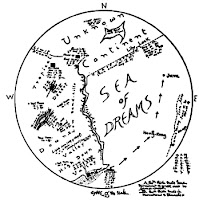Sometimes I wonder about the point of writing at any length about as complex a work as The Portrait of a Lady given that I have read it once and cannot possibly have caught much more than the central movement of the story.
One thing I missed and then missed some more was James’s use of metaphors.
He expressed this view, somewhat after this fashion, to his mother, who looked at him as if he had been dancing a jig. He had such a fanciful, pictorial way of saying things that he might as well address her in the deaf-mute’s alphabet.
“I don’t think I know what you mean,” she said; “you use too many metaphors; I could never understand allegories.” (Ch. 26)
I was misreading so badly that I thought James was at this point making a joke about his lack of metaphors, when in fact he was directly telling me – well, indirectly – that he used them all the time. There are two in the first two lines I quote! I enjoyed them for their humor without registering their frequency.
Di at The little white attic has been reading The Portrait of a Lady, too – in fact she invited me to read it now instead of (vague gesture) some other time – and she saw the metaphors. Look at all of those metaphors. But I now see how I did not see them. Look at the journalist Henrietta Stackpole, “strongly identified as a newspaper-woman,” as Di says, meaning as a woman made of newspaper:
She rustled, she shimmered, in fresh, dove-coloured draperies, and Ralph saw at a glance that she was as crisp and new and comprehensive as a first issue before the folding. From top to toe she had probably no misprint. (Ch. 10, the bold will be used in a minute)
And there’s more like that. My first problem was that these clever comparisons are not actually visual, not meant to help me see what James is imagining, but rather to quickly get a sense of what Henrietta is like, or perhaps what Ralph is like, since the comparisons are his. If I am looking for sensual precision, the way Zola or Nabokov or Bellow use metaphors, well, forget it. They want me to imagine the thing they are seeing, against the limitations of language. James wants me to meet the person he has imagined.
Di has many more examples just as good, but I picked this one because of the second reason I missed it – it’s not in the book I read. James made huge changes to the passage for the 1908 New York edition. The original 1881 edition, which I read, has:
She was very well dressed, in fresh, dove-coloured draperies, and Ralph saw at a glance that she was scrupulously, fastidiously neat. From top to toe she carried not an ink-stain.
I could go either way on the last example, but the first two, no contest, right? 1908 James came up with some good ones. Eh, even “no misprint” is funnier.
So, maybe I missed less than I think, and, without denigrating the book I read, next time I am reading the New York edition.
I should point to more of Di’s posts. The one on silence is the perfect counter to my complaint that Portrait talks too much. She calls her wrap-up “The greatness of Henry James,” which is a good place for me to stop.



